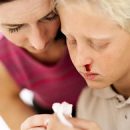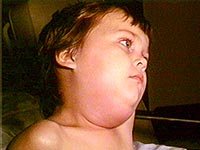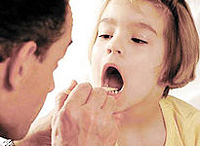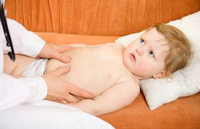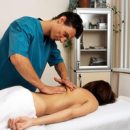Despite the fact that children's infections are most often occurring in a light form, serious complications are possible. Each parent should know the main signs of acute infectious diseases in children in order to seek medical attention in a timely manner.
Content
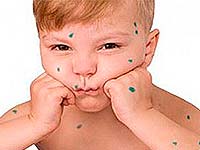 Infectious diseases in children — One of the main problems in pediatrics. They are known for a long time and are caused by various microorganisms. Descriptions of infections can be found in the ancient Indian, Chinese, Egyptian manuscripts. In Russian chronicles, they were mentioned as caustic scoring, which emphasized their extreme contagiousness, massiness and accompanying high mortality.
Infectious diseases in children — One of the main problems in pediatrics. They are known for a long time and are caused by various microorganisms. Descriptions of infections can be found in the ancient Indian, Chinese, Egyptian manuscripts. In Russian chronicles, they were mentioned as caustic scoring, which emphasized their extreme contagiousness, massiness and accompanying high mortality.
Infectious diseases in general — This is a large group of diseases that develop as a result of the impact on the human body of various viruses, bacteria and simplest. But among all this mass, there are infectious diseases that are striking mostly babies, they were combined into a group «Children's infections».
Children's infections include the following acute infectious diseases (in children and in adults):
- measles;
- rubella;
- chickenpox (chickenpox);
- Epidemic parotitis (pig);
- scarlet fever;
- whooping cough;
- polio;
- diphtheria.
Today, thanks to the vaccination of children, the incidence of these infections is significantly lower than in the former times, when, for example, the same Scarlatina worked millions of lives. However, the reassure is no reason, sporadic cases and small flashes of measles, rubella, windmills and vapotitis are found in children's teams. Each parent must know the main signs of infectious diseases in children in order to seek medical attention in a timely manner. Despite the fact that children's infections are most often occurring in a light form, serious complications, up to a deadly outcome, are also possible if the recommendations of the doctor are ignored and sanitary and hygienic events are not conducted.
Measles
Measles — Viral acute infectious disease, children flowing pretty hard and often with complications, prevent that you can, vaccinating a child.
For measles, a typically phased appearance of symptoms, the presence of a period of catarrhal phenomena, similar to the signs of all viral infections, the rash period characterized by the appearance on the body of a specific rash, and the period of recovery, in which skin pigmentation occurs on the place of rash.
Signs of Corey
- Beginning of the disease with a sharp increase in temperature, runny nose, cough, throat pain.
- Svetuboyaznny, sclerite, conjunctivitis.
- The appearance of small whiten spots on the surface of the mucous cheeks in front of the indigenous teeth (Belsky stains — Filatova — Sokilka) and red spots in the sky.
- Power Power: face, then torso and limb, then legs.
Rubella
Rubella — viral infection, more often flowing easily.
Her reference signs:
- Symptoms of symptoms;
- lack of high temperature and pronounced intoxication;
- The appearance of rashes is predominantly on the inner surface of the hands and legs, on the buttocks;
- The presence of rhinitis and pharyngitis, the appearance of reddish fine spots on the soft sky;
- Increase and soreness of the rear cervical and occipital lymph nodes.
Scarlet fever
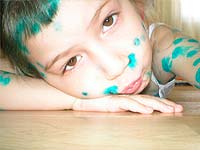 Scarlet fever — Bacterial infection caused by streptococcus hazardous all possible complications. Her main manifestation is distinguished by angrint, typical rash on the face in the form of small dots, located on the cheeks, on the forehead, on the chin, the rash on the body, on the side surfaces of the body, under the knees, under the slices, on the elbow bends, bright red tongue with increased inflamed papillars resembling a raspberry berry. For scarletna is characteristic of the peeling of the skin after the disappearance of the rash, and on the palms and footsteps it departs with whole plates.
Scarlet fever — Bacterial infection caused by streptococcus hazardous all possible complications. Her main manifestation is distinguished by angrint, typical rash on the face in the form of small dots, located on the cheeks, on the forehead, on the chin, the rash on the body, on the side surfaces of the body, under the knees, under the slices, on the elbow bends, bright red tongue with increased inflamed papillars resembling a raspberry berry. For scarletna is characteristic of the peeling of the skin after the disappearance of the rash, and on the palms and footsteps it departs with whole plates.
Chicken pox
Signs of acute infectious disease in children is the appearance of rash throughout the body. In addition, it has a view of a tubercle that turns into a bubble, filled with light liquid, which is opening up, leaves after himself a small erosion. Rashes are repeated several times, so you can detect various elements of the rash on the body.
Parotitis
Typical for epidemic parotitis feature is an increase and painfulness of the salivary glands, which is why the child's face acquires a characteristic view, the presence of pain when swallowing and chewing. Infection is dangerous by the development of pancreatitis, orchitis, meningitis.


